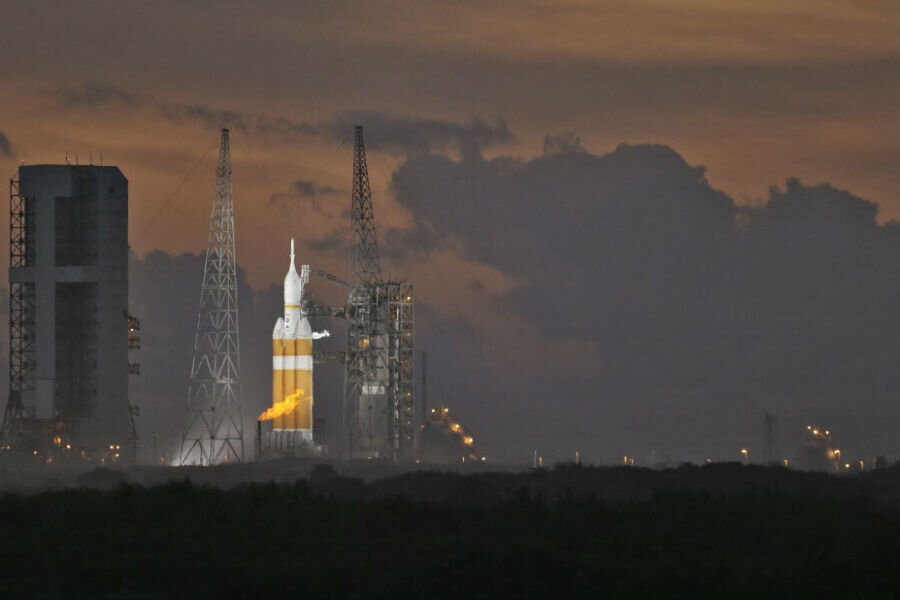Historic Orion launch delay: What went wrong?
The first test flight of NASA’s Orion deep-space exploration craft has been rescheduled for Friday morning following a series of delays Thursday that prompted mission managers to cancel the launch.
The delays left mission control at the Cape Canaveral Air Force Station with little time to solve the final problem – balky valves that fill and drain the liquid-hydrogen fuel tanks on the Delta IV "heavy" rocket – in time to beat a 9:44 a.m. deadline for launching.
That time marked the end of a 2 hour, 39 minute launch window established to ensure that Orion's initial test flight would begin and end with the best lighting conditions for launch and recovery.
Assuming an on-time launch at 7:05 a.m. Eastern Standard Time and no hitches along the way, Orion was slated to splash down in the Pacific Ocean off of Baja California at 11:29 p.m. EST. The test flight is designed to take the craft on two orbits of Earth, the second of which would carry Orion some 3,600 miles above Earth before heading back for reentry.
Orion would have become the first human-rated spacecraft to reach beyond low-Earth orbit in 42 years. Not since Apollo 17 in 1972, the final mission sending US astronauts to the moon, has a craft designed for crews traveled so far.
NASA's Mercury, Gemini, and Apollo programs in the 1960s and '70s led to humans setting foot on the moon for the first time, said NASA Administrator Charles Bolden Jr., adding that the shuttle and space station programs gave the US and its partners a start at learning to build and work with space-based infrastructure "that everybody knew was going to be necessary if we were really serious about deep-space exploration."
For NASA, a successful Orion launch would represent "Day One, the beginning of the Mars era" for human spaceflight, Mr. Bolden said during the run-up to this morning's launch attempt.
Now, “Day One” will arrive a bit later than planned.
Launch day play-by-play
The morning began auspiciously enough, with no technical problems appearing prior to a planned last-minute hold to ensure all systems were ready for the countdown's final steps. It looked as though the launch would occur on schedule.
For its part, Orion's systems were operating as planned, said Michael Hawes, who heads the Orion program at Lockheed Martin, during a post-scrub briefing Thursday. Lockheed Martin is building the craft.
Then, a ship appeared to stray into restricted waters offshore, an event similar to one that delayed by a day Orbital Sciences Corp.'s attempt to launch a cargo capsule to the International Space Station in late October.
"Ultimately, the boat was in a safe spot," said Daniel Collins, chief operating officer for the United Launch Alliance, a partnership between aerospace giants Lockheed Martin and Boeing Co., during the briefing. ULA is responsible for getting Orion into space.
But the incident prompted a slight delay in the launch time as mission controllers shifted the scheduled lift-off to 7:17 a.m.
Mission managers were forced to temporarily abort the launch a short time later when wind speeds at ground level exceeded the 24-mile-an-hour limit for the direction from which the wind was blowing. The Delta IV "heavy" is a powerful rocket, but its shape leaves it sensitive to winds that might not faze a singe cylindrical rocket because the beefed up Delta uses three first-stage boosters attached side by side, in addition to a second stage and Orion stacked atop the center booster.
Wind striking the booster array face-on will have more influence than a comparable wind striking the booster assembly edge on, Mr. Collins explained. Wind speeds will determine how much the 1.6-million-pound stack will drift as it rises. With launch-support structures close by, winds from the wrong direction and at the right strength raise the risk of driving the rocket into one of the structures as the rocket first rises.
As winds subsided, controllers reset the launch for 7:55 a.m., only to face another wind delay a short time later. The new launch time: 8:26 a.m.
Less than 10 minutes after managers set the new time, controllers called for another launch abort. This time, it appeared that valves controlling the flow of liquid hydrogen into and out of tanks in two of the rocket's trio of boosters failed to close properly in advance of launch.
Engineers came up with a scheme to close the valves, and, for good measure, to test all of the fill-and-drain valves for liquid hydrogen and liquid oxygen in all three first-stage boosters to ensure they were working correctly.
While mission managers set 9:44 a.m. as the final launch time for the day, it became clear that the better part of valor was to stand down and try again Friday morning. With less than 10 minutes left in Thursday's launch window, they rescheduled the launch.
Engineers are reviewing data from the rocket to get a more precise bead on what happened with the valves, but Collins noted that the same issue cropped up on another Delta IV "heavy" launch that had undergone a similar series of launch delays. Because liquid hydrogen is substantially colder than liquid oxygen, the valves' prolonged exposure to such extreme cold is one possible explanation for the delay that prompted managers to cancel the day's launch.
Members of the launch team "were absolutely on their game today, listening to everything the rocket was telling us" he said. "It ultimately told us it wasn't ready to go."







